There’s pervasive fear and panic within the parents’ community that the country’s 1.08 million government and 328,845 private recognised schools (and an estimated 300,000 unrecognised private budget schools) with 250 million children, are rapidly turning into danger zones lacking the most basic child safety and security measures - Summiya Yasmeen
 June 12. A 57-year-old founder-trustee of an upscale school in Mumbai is booked for the alleged rape of a three-year-old student on the school premises.
June 12. A 57-year-old founder-trustee of an upscale school in Mumbai is booked for the alleged rape of a three-year-old student on the school premises.
July 4. A three-and-a-half-year-old girl is molested by her school van driver while being dropped home from her preschool in Bangalore.
August 9. Over 500 parents stage a protest at a school in Malad, Mumbai after the alleged rape of a three-year-old girl by the school peon.
September 8. Pradyuman Thakur, a seven-year-old class II student of Ryan International School, Bhondsi (Gurgaon), is found dead in the school toilet with his throat slit allegedly by the school bus conductor.
September 15. A nine-year-old girl is alleged to have been digitally raped by her teacher inside the premises of a government school in Gurgaon.
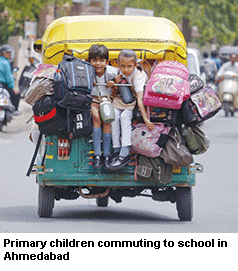 The upsurge in horror stories being reported from within the country’s 1.40 million schools, particularly the death of seven-year-old Pradyuman in the upscale Ryan International School, Gurgaon, has precipitated a wave of middle class and media outrage, focusing national attention on the issue of child safety as never before. There’s pervasive fear and panic within the parents’ community that the country’s 1.08 million government and 328,845 private recognised schools (and an estimated 300,000 unrecognised private budget schools) with 250 million children, are rapidly turning into danger zones lacking the most basic child safety and security measures.
The upsurge in horror stories being reported from within the country’s 1.40 million schools, particularly the death of seven-year-old Pradyuman in the upscale Ryan International School, Gurgaon, has precipitated a wave of middle class and media outrage, focusing national attention on the issue of child safety as never before. There’s pervasive fear and panic within the parents’ community that the country’s 1.08 million government and 328,845 private recognised schools (and an estimated 300,000 unrecognised private budget schools) with 250 million children, are rapidly turning into danger zones lacking the most basic child safety and security measures.
A report released in February this year by the ChildFund Alliance, an international network of 11 child-focused development organisations, found that one of every three children in Indian schools feels unsafe. The results of the global survey conducted across 41 countries highlighted deficient infrastructure, lack of toilet facilities, corporal punishment, bullying, among other safety hazards in schools as the “major concerns of children in India”.
The knee-jerk reaction of the Union human resource development (HRD) ministry and its hand maiden the Central Board of Secondary Education (CBSE), which has 19,527 schools (including Ryan International, Gurgaon) affiliated with it, to the media and public fury in the aftermath of Pradyuman’s ghastly murder are issuance of a series of ‘safety circulars’ to school managements. While the HRD and women and child development ministries directed schools to appoint women staff on school buses, educate children and teachers about gender sensitivity, popularise its child helpline (1098), among other measures, the CBSE ordered its affiliated schools to conduct security/safety audits of their premises and personnel as per the board’s safety manual and ensure that class IV employees — cooks, cleaners, gardeners, bus drivers and conductors — are registered with local police stations. The CBSE circular dated September 12 has given affiliated schools a two-month period to comply and report compliance online on www.cbse.nic.in. “Any violation/lapses with regard to safety and well-being of children on school campus would invite appropriate action including the disaffiliation of the school as per the provisions under affiliation bye-laws of the board,” says the CBSE circular (see box).
It’s pertinent to note that 13 years ago on July 16, 2004 when a deadly fire at the Sri Krishna/Saraswathi English Medium School in the obscure town of Kumbakonam (Tamil Nadu) charred 93 boys and girls aged between six and ten years to death, the Central and Tamil Nadu governments had similarly issued a flurry of safety guidelines. More recently (August) while hearing a petition filed by Avinash Mehrotra seeking safety guidelines for schools after the DAV School, Dabwali (Haryana) fire (1995) in which 258 school children died followed by the Kumbakonam tragedy, the Supreme Court ordered the education ministries of all 29 states and seven Union territories countrywide to ensure immediate implementation of the National Disaster Management Authority’s School Safety Policy 2016.
Likewise in July 2014 after the heinous rape of a six-year-old girl child of the upmarket CISCE-affiliated Vibgyor High School in Bangalore allegedly by two gym instructors was reported, following strident protests by middle class parents, students and NGOs, the Karnataka state government and police issued a number of safety guidelines to schools. Among them: installation of CCTV cameras in classrooms, compulsory presence of women attendants in school buses, appointment of teachers as vigilance officers, photo-identity cards for parents and school staff, restriction of movement of bus and van drivers within school campuses and appointment of additional security guards.
 “The great majority of schools in India do not have adequate safety systems and processes, leaving children at great risk, and accidents are waiting to happen. The response of the establishment — the Supreme Court, Union ministries of HRD and women and child welfare, state governments, police departments among other authorities — is to issue a plethora of safety guidelines. The multiple safety circulars can confuse even a security expert let alone school principals, who must translate these into simple SOPs (standard operating procedures) for effective implementation. The Central government needs to follow the lead of the UK’s Department for Education and Employment and appoint an expert committee which will convert these multiple guidelines into cogent and rational publications covering all areas of school safety such as buildings, playgrounds, labs, buses, etc,” says Capt. Raj Mohindra, founder and managing director of the Mumbai-based Raj Mohindra Consultants Pvt. Ltd, a pioneer education consultancy which has helped establish several internationally benchmarked schools including the Mahindra United World College of India, Pune, Dhirubhai Ambani International and Ecole Mondiale World School, Mumbai.
“The great majority of schools in India do not have adequate safety systems and processes, leaving children at great risk, and accidents are waiting to happen. The response of the establishment — the Supreme Court, Union ministries of HRD and women and child welfare, state governments, police departments among other authorities — is to issue a plethora of safety guidelines. The multiple safety circulars can confuse even a security expert let alone school principals, who must translate these into simple SOPs (standard operating procedures) for effective implementation. The Central government needs to follow the lead of the UK’s Department for Education and Employment and appoint an expert committee which will convert these multiple guidelines into cogent and rational publications covering all areas of school safety such as buildings, playgrounds, labs, buses, etc,” says Capt. Raj Mohindra, founder and managing director of the Mumbai-based Raj Mohindra Consultants Pvt. Ltd, a pioneer education consultancy which has helped establish several internationally benchmarked schools including the Mahindra United World College of India, Pune, Dhirubhai Ambani International and Ecole Mondiale World School, Mumbai.
According to Mohindra, who has authored a paper School Safety and Security, the selective targets of government/police/CBSE safety circulars are the country’s 320,000 private schools with the government conveniently exempting 1.08 million public schools from implementation. “As in the Ryan International School case, promoters of private schools are targeted by the media and government for violation of safety norms while government schools are not accountable. Just a week after Pradyuman’s murder, a girl student was raped by a teacher in a government school in Gurgaon. Neither the media nor parents called for the arrest of the education minister. The government’s safety guidelines should be applicable to government schools as well,” he says.
There’s no gainsaying that there is wide disparity in the child security standards followed by the country’s high-end international schools affiliated with foreign exam boards such as International Baccalaureate, Geneva and Cambridge Assessment International Education (UK), private schools affiliated with the pan-India CISCE and CBSE boards, state board-affiliated private and government schools. Within the majority of the 470 new genre international schools and 23,000 CBSE and CISCE-affiliated schools, there is at least basic awareness of safety management processes and procedures, while the top-ranked among them go to great lengths to ensure safety of their students, the real problem is further down the pecking order in the 1.37 million private and government primary-secondaries affiliated with the 29 state examination boards across the country. In these state and local government schools where blackboards, desks, chairs, drinking water and toilets are rarities and teacher absenteeism is the rule rather than the exception, fire extinguishers, safety manuals and drills are viewed as luxuries designed for effete urbanites. EducationWorld correspondents across the country visited and interviewed a cross-section of schools/principals to report on their safety systems.
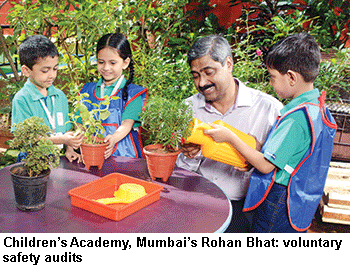 In Mumbai, the Children’s Academy Group of three CISCE co-ed day schools with an aggregate enrolment of 10,000 students, conducts safety audits every six months. “Though unlike CBSE, the CISCE board has not made it compulsory for affiliated schools to conduct safety audits, we have been conducting them religiously every six months for the past five years. We have prepared an excellent safety manual and SOP under which background checks and police verification of all staff members are conducted, there are separate toilets for adults and students, women attendants supervise toilets on each floor and all our schools are under CCTV surveillance. Moreover we hold fire drills every six months, and maintain high food and hygiene standards in the canteens. Recently, we also changed the design of our school buses to install an aluminium ladder which can be used for emergency evacuation. Most importantly, all our three schools regularly conduct the ‘3S’ — Safe, Secure School — workshops for teachers and support staff to enable them to implement safety measures on the ground,” says Rohan Bhat, chairman of the Children’s Academy Group of schools.
In Mumbai, the Children’s Academy Group of three CISCE co-ed day schools with an aggregate enrolment of 10,000 students, conducts safety audits every six months. “Though unlike CBSE, the CISCE board has not made it compulsory for affiliated schools to conduct safety audits, we have been conducting them religiously every six months for the past five years. We have prepared an excellent safety manual and SOP under which background checks and police verification of all staff members are conducted, there are separate toilets for adults and students, women attendants supervise toilets on each floor and all our schools are under CCTV surveillance. Moreover we hold fire drills every six months, and maintain high food and hygiene standards in the canteens. Recently, we also changed the design of our school buses to install an aluminium ladder which can be used for emergency evacuation. Most importantly, all our three schools regularly conduct the ‘3S’ — Safe, Secure School — workshops for teachers and support staff to enable them to implement safety measures on the ground,” says Rohan Bhat, chairman of the Children’s Academy Group of schools.
Down south in the Tamil Nadu State Board of School Education-affiliated Hari Om Matriculation School, a private school with 450 students and 27 teachers sited in the textile city of Coimbatore, safety and fire hazard precautions are less exemplary. The school has one CCTV camera at the entrance and no fire extinguishers. “We have two trustworthy watchmen at the gates and one near the restrooms to ensure no outsiders enter them and all our buses have a lady attendant. There’s a CCTV camera at the entrance which is now under repair. All our employees live close by and have good references though we haven’t got employees’ security clearances from the local police. Our students come from middle class families which cannot afford to pay for expensive safety equipment such as CCTV cameras. The fees are very low, so whatever safety measures we have undertaken are fully funded by the management,” says R. Premalatha, principal of the school.
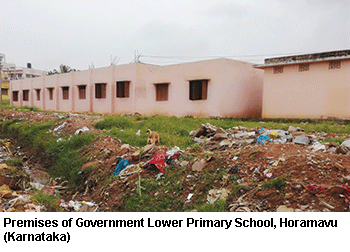 Indeed the refrain of the majority of private school managements especially those catering to middle class households, is that parents are unwilling to pay additional fees to fund safety equipment such as CCTV cameras and fire extinguishers, employ additional security staff, conduct employee background checks etc — as mandated by the plethora of safety circulars issued by the government and police. Instead across the country, middle class parents are ill-advisedly clamouring for government ‘regulation’ of tuition fees already being charged by India’s 328,845 recognised private schools.
Indeed the refrain of the majority of private school managements especially those catering to middle class households, is that parents are unwilling to pay additional fees to fund safety equipment such as CCTV cameras and fire extinguishers, employ additional security staff, conduct employee background checks etc — as mandated by the plethora of safety circulars issued by the government and police. Instead across the country, middle class parents are ill-advisedly clamouring for government ‘regulation’ of tuition fees already being charged by India’s 328,845 recognised private schools.
Most state governments including Haryana, Rajasthan, Gujarat and Tamil Nadu have responded to this parental demand and introduced legislation to regulate private school fees. For instance, under the Gujarat Self-financed Schools (Regulation of Fees) Act, 2017, passed by the state legislative assembly on March 30, all private primary, secondary and higher secondary schools including schools affiliated with CISCE, CBSE, international and state boards, are subject to tuition fee ceilings — Rs.15,000 per year for primaries, Rs.25,000 for secondaries, and Rs.27,000 for higher secondaries. Private school managements, under pressure to improve infrastructure, teacher training and welfare, learning outcomes, co-curricular and sports facilities, and now to adhere to the flood of government/police-issued safety circulars, argue that superior holistic education in safe learning environments just can’t be delivered at low fees.
Even as private school managements are grappling with the fees regulation fever and the government mandate to implement multiple safety guidelines suggesting expensive, quick-fix solutions, the country’s 1.08 million government schools have no such safety compliance worries. Cash-strapped state governments have conveniently exempted government schools from implementing the safety guidelines supposedly issued for “all schools”. For the majority of state and local government schools which lack even basic infrastructure — according to DISE (District Information System for Education), 2014-15, 32 percent don’t have compound walls, 5.6 percent don’t provide separate toilets for girls, 38 percent lack playgrounds and 31 percent electricity connections — fire extinguishers, safety manuals and drills, security personnel, and CCTV cameras are lavish indulgences.
An example of official neglect and indifference to the safety and well-being of children from poor households studying in government schools is provided by the Government Lower Primary School, Jayanthi Nagar, Horamavu, a suburb of Bangalore. Sited on a generous 3-acre plot, the school has no compound wall on any side and the playground is a thoroughfare for the public, dogs, cows and sundry others. The public dumps waste in the compound, mostly in the open drain that runs beside the school, leaving it to rot with the foul smell lingering in the air.
At the time EducationWorld correspondent Sruthy Susan Ullas visited the school, a van carrying midday meals from the Akshaya Patra Foundation had arrived and some class V students rushed to transfer the hot, heavy steel vessels with their bare hands. There is one fire extinguisher in the school but none of the teachers knows how to operate it; the toilets were locked and there are no CCTV cameras, ID cards or security guards and no safety audit has ever been conducted. “During school hours, we manage to keep the public from using the school verandahs. But after school, there’s little we can do. There have been many instances of unruly men drinking on campus and the public dumping waste on our campus at night,” says Haladamma A.S, a teacher at the school.
An estimated 36,000 classrooms in government schools across Karnataka are in danger of collapse and need urgent repair. Last year, a government school building in Belagavi district collapsed killing two children. The state’s Sarva Shiksha Abhiyaan U-DISE 2016-17 report says 40,000 public school buildings are in a dilapidated condition and 10,000 lack compound walls.
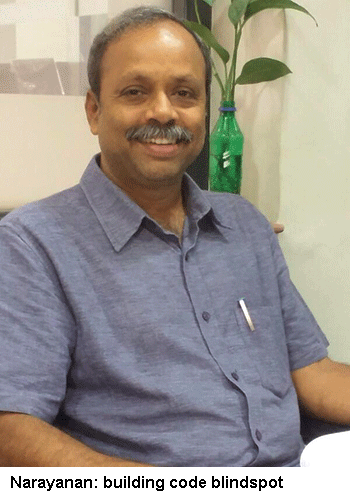 According to A. Narayanan, founder of the Chennai-based NGO Change India, although the Supreme Court decreed in 2009 that every school — government and private — should adhere to the National Building Code 2005, most state governments haven’t bothered to ensure its implementation. “State governments across the country have failed miserably in ensuring that the National Building Code is followed by all schools. The apex court had also recommended that district level committees comprising experts conduct an annual inspection of all schools to ensure compliance. But the government doesn’t have the manpower or resources to inspect schools. Many private schools have narrow staircases, asbestos roofs and single exits. Private school managements are hand-in-glove with state education departments, while in government schools the government is simply not bothered,” says Narayanan who has filed a petition in the Madras high court seeking action against the Hyderabad-based Narayana Group of Schools, which has established 14 schools in Chennai, for violating building safety norms.
According to A. Narayanan, founder of the Chennai-based NGO Change India, although the Supreme Court decreed in 2009 that every school — government and private — should adhere to the National Building Code 2005, most state governments haven’t bothered to ensure its implementation. “State governments across the country have failed miserably in ensuring that the National Building Code is followed by all schools. The apex court had also recommended that district level committees comprising experts conduct an annual inspection of all schools to ensure compliance. But the government doesn’t have the manpower or resources to inspect schools. Many private schools have narrow staircases, asbestos roofs and single exits. Private school managements are hand-in-glove with state education departments, while in government schools the government is simply not bothered,” says Narayanan who has filed a petition in the Madras high court seeking action against the Hyderabad-based Narayana Group of Schools, which has established 14 schools in Chennai, for violating building safety norms.
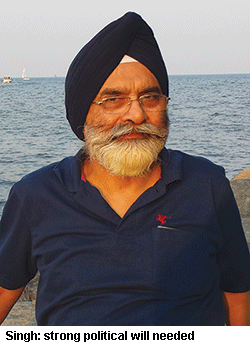 Dr. Avtar Singh, a Delhi-based educationist and an empanelled assessor for school accreditation of the National Accreditation Board for Education and Training of the Quality Council of India, believes that child safety is grossly neglected in low-end private and government schools because of lack of sincerity in following rules and regulations, and corruption. “Managements of the vast majority of private schools have well-established and durable political and bureaucratic connections; hence they are confident of no action by government agencies/departments. In government schools, it’s lack of adequate financial resources and chalta hai attitude of politicians and bureaucrats towards the safety of under-privileged children. Strong political will is needed to frame a National Child Protection Policy. Moreover, child safety training programmes for teachers and support staff and safety audits by credible institutions such as the Quality Council of India need to be made mandatory for all government and private schools,” says Singh.
Dr. Avtar Singh, a Delhi-based educationist and an empanelled assessor for school accreditation of the National Accreditation Board for Education and Training of the Quality Council of India, believes that child safety is grossly neglected in low-end private and government schools because of lack of sincerity in following rules and regulations, and corruption. “Managements of the vast majority of private schools have well-established and durable political and bureaucratic connections; hence they are confident of no action by government agencies/departments. In government schools, it’s lack of adequate financial resources and chalta hai attitude of politicians and bureaucrats towards the safety of under-privileged children. Strong political will is needed to frame a National Child Protection Policy. Moreover, child safety training programmes for teachers and support staff and safety audits by credible institutions such as the Quality Council of India need to be made mandatory for all government and private schools,” says Singh.
Undoubtedly if schools have become hazard zones endangering the lives of millions of children, the prime villains are state and local government officials who fail and neglect to enforce laws and regulations enacted to protect them. Take for instance the wide range of school transport safety regulations issued by state governments, transport departments and the Supreme Court, which are practiced more in the breach than observance.
Every school day, the lives of thousands of children travelling in overcrowded autorickshaws and vans are fraught with danger, because of poor enforcement of road safety rules. In 2012, the Supreme Court ruled that a school van can ferry students one-and-a-half times its seating capacity only if the children are less than 12 years of age, and that the speed limit should not exceed 40 kmph. But hardly any school or private vehicle services follow this apex court diktat. According to data of the National Crime Records Bureau, 15,633 children were killed in road accidents across India in 2015, of whom over 400 died in school bus-related accidents.
To the growing list of dangers — road accidents, fires, dilapidated buildings, etc — school children are now exposed to the rising incidence of sexual abuse. Over the past decade, there’s been a sharp upsurge in child molestation and abuse cases reported from school campuses countrywide. For instance since July 2014, after the rape of a six-year-old girl child of the Vibgyor High School in Bangalore, the city has witnessed a spate of child sexual abuse crimes. According to police sources, crimes registered under the Protection of Children from Sexual Offences (POCSO) Act, 2012, have increased from 55 in 2013 to 175 in 2014. And in most cases, the accused have been identified as school bus drivers, conductors, peons, and other support staff. The government has responded by directing schools to install CCTV cameras, conduct police verification of support staff, restrict movement of bus and van drivers within school premises and appoint additional security guards.
Yet there is a deafening silence about the causal link between the easy access to pornography on the Internet in the new millennium, and the rising incidence of sex crimes against children. With 400 million Internet users in India, the multiplying number of pornography sites — the Central government ill-advisedly reversed a ban imposed on 857 pornographic websites in August 2015 — have undoubtedly played a major role in unhinging the minds of a substantial number of illiterate people countrywide and created entire communities of sexual predators. “I am convinced that the easy and wide availability of Internet pornography is a causative factor behind the huge rise in child sexual abuse cases being reported from schools across the country. When uneducated, gullible people with undisciplined minds have easy access to porn including child abuse pornography, there’s danger this can unbalance them. Moreover the lack of sex education in schools prompts the gullible to enact their fantasies into reality. The government should take notice and limit access of Internet pornography in a society plagued with widespread illiteracy and steeped in patriarchy,” says Dr. S. Ramesh, the highly-respected consultant physician of the Manipal Hospital, Bangalore.
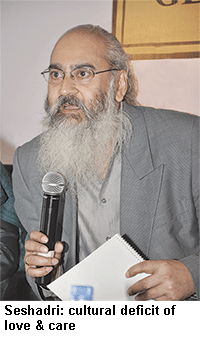 However, Dr. Shekhar Seshadri, professor of child and adolescent psychiatry at the National Institute of Mental Health and Neuro Sciences (NIMHANS), Bangalore, believes the rising incidence of child sexual abuse and neglect of child safety is rooted less in easy access to Internet pornography than in a national cultural deficit of love and care of children. “India lacks a culture of care and respect for children’s rights. We like to pay lip service to child safety but in reality child-parent/adult relationships are rooted in obedience, silence and patriarchy. Indian society’s strong patriarchal culture inhibits adults from creating meaningful spaces for children; in fact there is pernicious disbelief when children report sexual abuse. We need to develop and institutionalise a culture of child care and safety and build a strong response system within schools, homes, government, police and the judiciary. The conviction rate for child sexual abuse is less than 5 percent. A strong response system which has zero tolerance of child sexual abuse and violation of children’s rights will inhibit and deter potential abusers,” says Seshadri.
However, Dr. Shekhar Seshadri, professor of child and adolescent psychiatry at the National Institute of Mental Health and Neuro Sciences (NIMHANS), Bangalore, believes the rising incidence of child sexual abuse and neglect of child safety is rooted less in easy access to Internet pornography than in a national cultural deficit of love and care of children. “India lacks a culture of care and respect for children’s rights. We like to pay lip service to child safety but in reality child-parent/adult relationships are rooted in obedience, silence and patriarchy. Indian society’s strong patriarchal culture inhibits adults from creating meaningful spaces for children; in fact there is pernicious disbelief when children report sexual abuse. We need to develop and institutionalise a culture of child care and safety and build a strong response system within schools, homes, government, police and the judiciary. The conviction rate for child sexual abuse is less than 5 percent. A strong response system which has zero tolerance of child sexual abuse and violation of children’s rights will inhibit and deter potential abusers,” says Seshadri.
Indeed there’s emerging consensus within educators and childcare experts that the government/police is over-emphasising technological and surveillance solutions and ignoring ways and means to integrate a culture of safety and security of children into education institutions. They believe a culture of excessive surveillance and policing in schools will destroy children’s creativity and holistic development. Dr. Krishna Kumar, former professor of education at Delhi University, says that “surveillance is a recipe for destroying pedagogic ingenuity and imagination which depend on a sense of freedom and autonomy” (see Anniversary Essay).
 Meeta Sengupta, a Delhi-based writer, education advisor and founder of the School Safety Campaign which has produced an elaborate safety code and framework for schools, concurs. “Though CCTVs, security guards, etc are important to ensure the safety and security of children, schools are not jails in which children need to be monitored round-the-clock. We need to complement technology and surveillance with nurturing institutional cultures which promote child care and safety. Creating a culture of child safety requires mindset and attitudinal changes within school managements, teachers, parents and students. This has to be developed through awareness and training programmes for all these stakeholders,” says Sengupta, an alumna of IIM-Ahmedabad, who has worked with several blue-chip organisations including Citibank, JP Morgan and the London Business School.
Meeta Sengupta, a Delhi-based writer, education advisor and founder of the School Safety Campaign which has produced an elaborate safety code and framework for schools, concurs. “Though CCTVs, security guards, etc are important to ensure the safety and security of children, schools are not jails in which children need to be monitored round-the-clock. We need to complement technology and surveillance with nurturing institutional cultures which promote child care and safety. Creating a culture of child safety requires mindset and attitudinal changes within school managements, teachers, parents and students. This has to be developed through awareness and training programmes for all these stakeholders,” says Sengupta, an alumna of IIM-Ahmedabad, who has worked with several blue-chip organisations including Citibank, JP Morgan and the London Business School.
The challenge of ensuring child safety in the country’s 1.08 million government, 328,845 private recognised and estimated 300,000 unrecognised private budget schools requires a collaborative effort involving the State, schools and parents, says G. Balasubramanian, former director (academics) of the CBSE and author of Safety Issues in School (2012) published by the Quality Council of India. “School safety is not optional. It is the basic right of every child. Three important participants — State, systems and stakeholders — need to actively work together to make child safety a reality. The State enacts child safety laws and forgets about it. Therefore, we need a National Agency on School Safety with sub-units in all states to ensure implementation. Second, the primary responsibility for implementing safety systems is that of school managements which tend to be preoccupied with brand development, board results, etc. Each school needs to prepare and implement standard operating safety procedures. The other important stakeholders are parents who need to adopt a more positive and facilitative approach with schools to ensure strict implementation,” says Balasubramanian.
 Raj Mohindra, founder-managing director of Raj Mohindra Consultants, Mumbai, believes the country’s private school managements — which have come under sharp public and media attacks after the Ryan International School murder — need to take the lead in obtaining school safety accreditation. “India has an independent accreditation body of international standards — the Accreditation Commission for Conformity of Assessment Bodies (ACCAB) — which in 2016 offered National Safe School Accreditation to schools and educational institutions. This first-of-its-kind initiative is based on the National School Safety Policy guidelines published by the National Disaster Management Authority of India, the United Nations Convention on the Rights of the Child and the National Early Childhood Care and Education Policy. Accreditation of schools will lead to institutionalisation of child safety processes,” says Mohindra.
Raj Mohindra, founder-managing director of Raj Mohindra Consultants, Mumbai, believes the country’s private school managements — which have come under sharp public and media attacks after the Ryan International School murder — need to take the lead in obtaining school safety accreditation. “India has an independent accreditation body of international standards — the Accreditation Commission for Conformity of Assessment Bodies (ACCAB) — which in 2016 offered National Safe School Accreditation to schools and educational institutions. This first-of-its-kind initiative is based on the National School Safety Policy guidelines published by the National Disaster Management Authority of India, the United Nations Convention on the Rights of the Child and the National Early Childhood Care and Education Policy. Accreditation of schools will lead to institutionalisation of child safety processes,” says Mohindra.
The tragic murder of seven-year-old Pradyuman Thakur of Ryan International School, Gurgaon, has once again provoked a nationwide debate on the issue of child safety in our schools, the roles of institutional managements, teachers, support staff, parents and most importantly government. But unfortunately this debate has one-sidedly focused on the inadequacies of the country’s much-maligned private schools, exempting the 1.08 million crumbling government schools, and resulted in another flood of safety circulars suggesting expensive, impractical and quick-fix solutions by the Central/state governments, police, judiciary, etc.
Pradyuman’s death will not have gone in vain if the Central government enacts a composite national child safety policy to be implemented in all schools — including government schools — in a time-bound manner. To develop our high-potential human resource, the safety and well-being of our 250 million school-going children is a non-negotiable national priority.
|
CBSE’s mandatory safety prescription
 In the aftermath of the tragic murder of seven-year-old Pradyuman Thakur in Ryan International School, Gurgaon, the Delhi-based Central Board of Secondary Education (CBSE) — the country’s largest pan-India exams board with 19,527 affiliated schools — issued a circular to its schools to conduct security/safety audits of their premises and personnel as per the board’s safety manual and ensure that their class IV employees — cooks, cleaners, gardeners, bus drivers and conductors — are registered at local police stations. The CBSE circular dated September 12 has given affiliated schools a two-month period to comply and report compliance online on www.cbse.nic.in. Excerpts: In the aftermath of the tragic murder of seven-year-old Pradyuman Thakur in Ryan International School, Gurgaon, the Delhi-based Central Board of Secondary Education (CBSE) — the country’s largest pan-India exams board with 19,527 affiliated schools — issued a circular to its schools to conduct security/safety audits of their premises and personnel as per the board’s safety manual and ensure that their class IV employees — cooks, cleaners, gardeners, bus drivers and conductors — are registered at local police stations. The CBSE circular dated September 12 has given affiliated schools a two-month period to comply and report compliance online on www.cbse.nic.in. Excerpts:
• The onus for safety and security of children on school campus shall solely lie upon school authorities. It is a fundamental right of a child to engage and study in an environment where he/she feels safe and is free from any form of physical or emotional abuse or harassment.
• Schools should also strive to promote a better understanding amongst their teachers and staff on the laws protecting the safety, security and interests of students and devise means to take immediate remedial and punitive action against such violations. Staff members should also be educated to recognise their protective obligation towards students and to ensure safety and well-being of children in schools.
• The ministry of human resource development (MHRD) has issued a comprehensive set of guidelines dated 09.10.2014 regarding preventive mechanisms and procedures for institutionalising a system to ensure safety and security of children in schools. The board has also from time to time issued instructions to implement and sensitise schools for ensuring the safety and security of students during school time and while in transit to school and back home.
• These exhaustive provisions are required to be strictly followed by every school affiliated with CBSE to ensure complete safety of children in school. In addition, the school authorities may immediately take following measures to enhance the security of children in schools:
(a) Get the security /safety audit done of their premises and personnel from their respective local police stations and follow the security-related advice for the safety of children. This may be complied and reported online on CBSE website www.cbse.nic.in within two months of receipt of this circular.
(b) Install CCTV cameras at all vulnerable areas/points on the school premises and ensure they are functional at all times.
(c) They must get police verification and psychometric evaluation done for all the staff employed. Such verification and evaluation for non-teaching staff such as bus drivers, conductors, peons and other support staff may be done very carefully and in a detailed manner.
(d) Ensure that support staff is employed only from authorised agencies and proper records are maintained.
(e) Constitute a parent-teacher-students committee to address the safety needs of students and to take regular feedback from parents in this regard.
(f) Access to school buildings by outsiders should be controlled and visitors monitored.
(g) Provide training and development for staff to address their responsibilities to protect children from any form of abuse.
(h) The school shall constitute separate committees for redressal of public/staff/parents/students grievances, internal complaints committees on sexual harassment and committees under POCSO (Protection of Children from Sexual Offence) Act, 2012 and details of these committees along with contact details shall be displayed prominently on the school notice board and conspicuously on the school website for information of all stakeholders.
It is reiterated, that all schools affiliated with CBSE are hereby directed to strictly adhere to all the guidelines issued by MHRD and board from time to time. Any violation/lapses with regard to safety and well-being of children on school campuses would invite appropriate action including the disaffiliation of the school as per the provisions under affiliation bye-laws of the board.
Author’s note: Unfortunately hundreds, if not thousands, of such humdrum circulars placing the entire responsibility for child safety on school managements have come and gone without changing the status quo. School managements are always under pressure from parents clamouring for government ‘regulation’ (i.e reduction) of fees, and therefore aren’t able to fully address the child/campus safety issue. Therefore the security of children requires cooperation between all stakeholders — school management, parents, teachers — because security is costly.
Managements could levy a fully transparent special ‘security cess’ separate and distinct from tuition fees. Parents are unlikely to object as they are prime beneficiaries.
|
|
“Impeccable safety record”
Sited over 20 acres in Geneva, Switzerland, College du Leman (CdL, estb. 1960) is a highly-respected day-cum-boarding school (annual tuition and other fees: Rs.18-60 lakh) with 2,089 students from over 120 countries on its muster rolls.
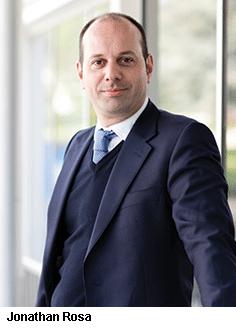 Jonathan Rosa, admissions education advisor of CdL, spoke to EducationWorld about the safety practices/processes practiced at this top-ranked international school. Excerpts: Jonathan Rosa, admissions education advisor of CdL, spoke to EducationWorld about the safety practices/processes practiced at this top-ranked international school. Excerpts:
What is the safety record of CdL? How many adult-child crimes have you had in the past 57 years when children are under the care of the school i.e while commuting in buses, on campus, classrooms, etc?
We have an impeccable safety record at College du Leman with no adult child crimes reported since the school was founded 57 years ago. We are a day-cum-boarding school with 1,839 day scholars and 250 boarders, aged 8-18 years from around the world. All incoming students provide our on-campus medical centre a completed health questionnaire on enrollment. We have qualified on-campus nurses and a visiting doctor. Full school fire evacuation drills are conducted regularly and equipment checked and maintained on a regular basis. Health and safety matters and areas of improvement are discussed between staff and students routinely. We have CCTV cameras across the campus and professional security agents who are on campus 24/7.
A lot of adult-child crimes in India occur in the bathrooms/toilets. What steps do you take to prevent such crimes?
All staff are trained annually on child protection and have to pass several tests every year to get clearance to work with children. We also conduct regular training sessions for students on how to keep themselves safe. Every child and staff member has to have an access key to enter all buildings and dorms, and there are inconspicuous security cameras and agents throughout the campus.
The parent profile of CdL is of high income households. What steps/measures have you taken against kidnapping of children for ransom?
We have security agents, CCTV cameras, and maintain the full history of all staff complete with their family, financial, physical and mental histories. Moreover, we have weekly pastoral care meetings to keep track of the mental and emotional health of all staff. Our assistant director of pastoral care was the former vice president of the British Boarding Schools Association which sets the safety benchmarks for schools in the UK.
Another phenomenon in India is that parents are not prepared to pay for additional security measures for children. What is the situation in CdL?
There’s no instance of parents protesting levies for children’s security. Our parents place their full trust in us and in return we undertake to provide the highest quality educational experience in a safe and secure environment.
In India most adult-child crimes are committed by teachers/lower grade staff. What are the suitability tests you conduct for teachers/support staff?
As I have said, we maintain complete histories and antecedents of all staff — family, financial, physical and mental histories. All staff have annual training on child safety and protection and are checked for mental and emotional stability by psychologists on campus who are also available for staff and students for confidential evaluation. Moreover, we maintain a support team for confidential meetings to report bullying of any type.
|
With Dipta Joshi (Mumbai), Hemalatha Raghupathi (Chennai) & Autar Nehru (Delhi)